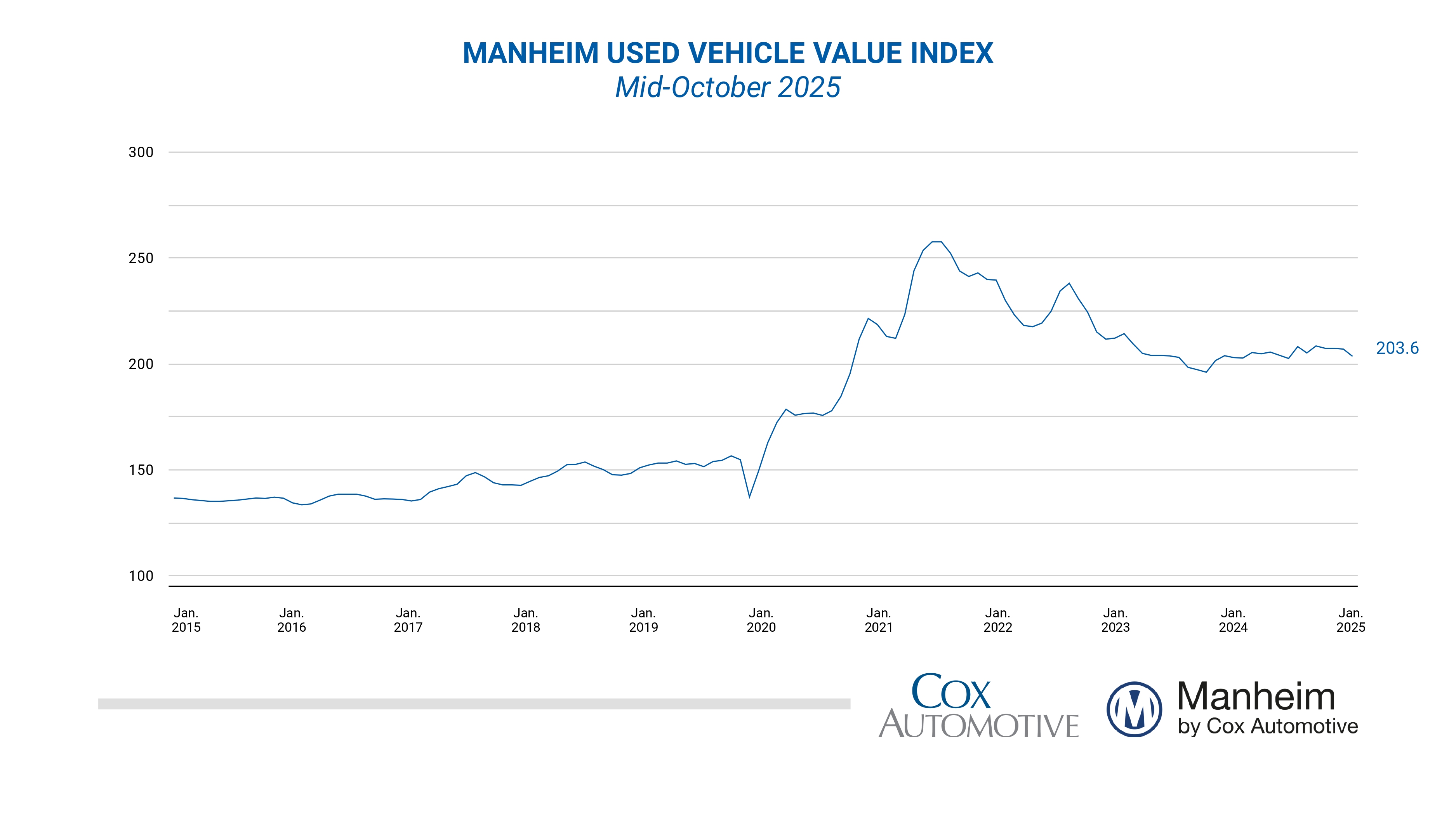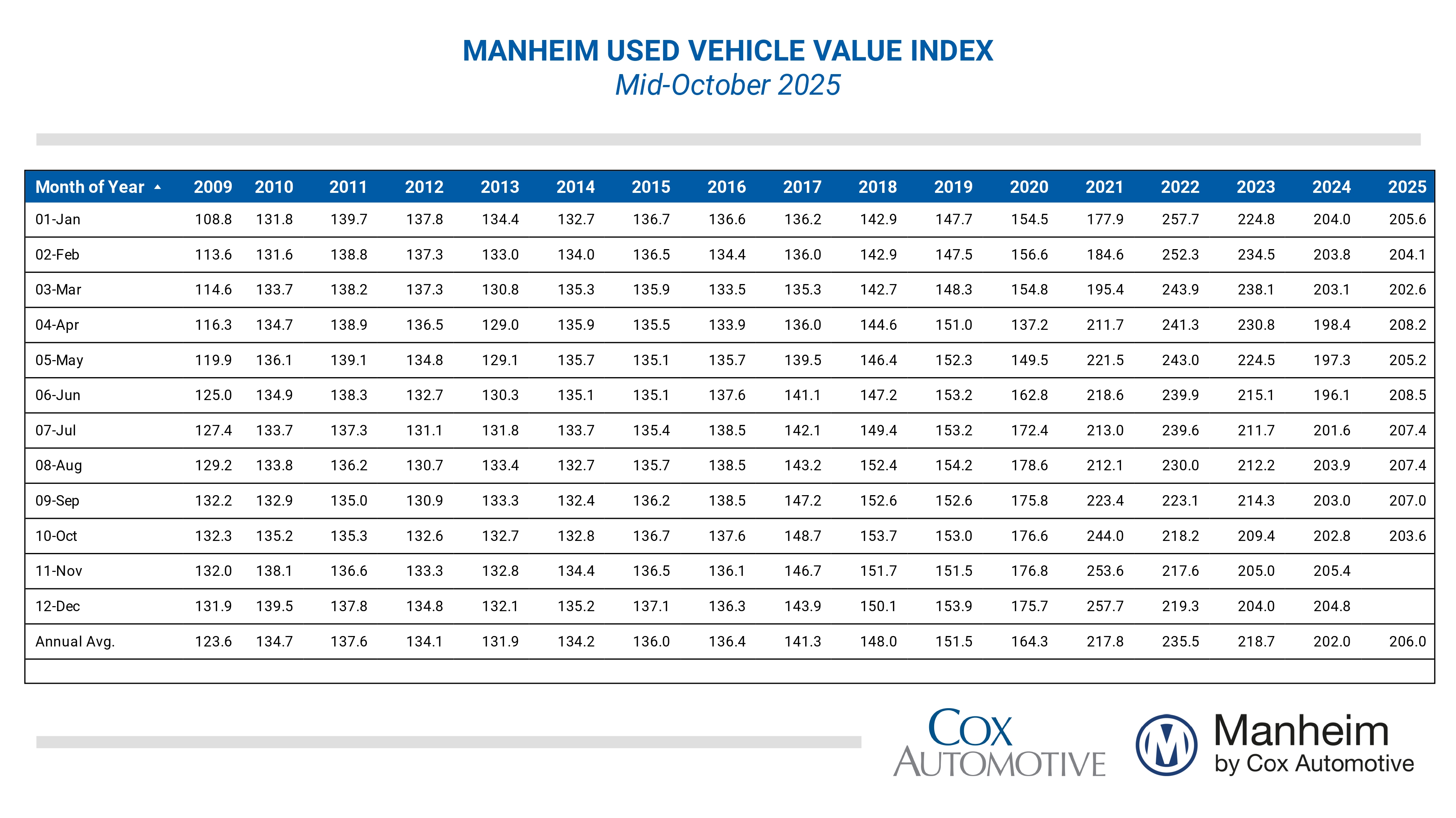Used Vehicle Value Index
Quarterly Conference Call
The next quarterly Manheim Used Vehicle Value Index (MUVVI) conference call is scheduled for Tuesday, Jan 8 at 11am ET.
Please RSVP to add the presentation to your calendar and see how to join.
Join Cox Automotive Chief Economist Jonathan Smoke, Jeremy Robb, senior director of Economic and Industry Insights, and Scott Vanner, Economic and Industry Insights analyst, as they discuss the latest Manheim Used Vehicle Value Index and the major economic and industry trends that shaped the quarter.
All questions related to the Manheim Used Vehicle Value Index and wholesale market can be sent to manheim.data@coxautoinc.com.
Listen to a recording of the last call.
View the Most Recent Presentation
The presentation will be available one hour before the conference call.
View Previous Presentations
By applying statistical analysis to its database of more than 5 million used vehicle transactions annually, Manheim has developed a measurement of used vehicle prices that is independent of underlying shifts in the characteristics of vehicles being sold. View the index methodology.
The Manheim Index is increasingly recognized by both financial and economic analysts as the premier indicator of pricing trends in the used vehicle market, but should not be considered indicative or predictive of any individual remarketer’s results.
Wholesale Used-Vehicle Prices Decrease in the First Half of October
Wholesale used-vehicle prices (on a mix-, mileage-, and seasonally adjusted basis) decreased from September in the first 15 days of October. The mid-month Manheim Used Vehicle Value Index fell to 203.6, showing a gain of 0.4% from the full month of October 2024. The seasonal adjustment amplified the impact for the month, as it was higher than typical. The non-adjusted price change in the first half of October fell 3.4% compared to September, and the unadjusted price is higher by 0.6% year over year. The average move for the full month of October is a decline of 1.5 percentage points for non-adjusted values, indicating the pricing declines observed so far in October are higher than normally seen for the full month.
Wholesale values started to show weakness in late September, and that has carried over into the first half of October, as price depreciation trends start to get back to normal levels,” said Jeremy Robb, deputy chief economist for Cox Automotive. “Declining retail sales in late September typically signal that we could see softer wholesale demand, a pattern holding at Manheim. While October typically shows the year’s strongest depreciation, current weekly declines are running higher than normal for this month, giving back some of the unusual price strength we maintained through most of 2025. The seasonal adjustment was smaller than typical for October, which amplified the month-over-month index decline.”
The Manheim Market Report (MMR) prices for the Three-Year-Old Index have declined by 1.2% so far in October, higher than the usual decline of 0.7% for this period. Over the first 15 days of October, MMR Retention, the average difference in price relative to current MMR, averaged 98.9%, moved further below valuation models over the first half of the month with a decline of 0.1 points from late September. MMR retention is also down by 0.1% compared to the first half of October 2024. The average daily sales conversion rate of 55.9% in the first half of the month was almost a point higher than last year’s level of 54.8% in the first half of the month. However, it is down by about 1.5 points compared to September, indicating a modest softening in demand.
Results by segment for seasonally adjusted prices year over year in the first half of October were somewhat mixed. Compared to the industry’s year-over-year increase of 0.4%, the luxury segment performed best, rising by 2.9%, followed by SUVs, which were lower by 0.3%, with the truck segment falling 1.6%. Mid-size cars fell 3.3%, and the compact car segment declined the most, lower by 5% against last year. The overall seasonally adjusted prices fell 1.6% in the first 15 days of October compared to the full month of September. The compact car segment was up by 1.6% during the first half of October, outperforming the overall market for that period. Trucks fell by 1.2%, the luxury segment fell 1.4%, and SUVs were down 1.9%. Mid-size cars fell the most, down 2.3% since the end of last month.
Electric vehicles (EVs) are showing the strongest year-over-year gains currently, with a year-over-year increase of 3.5% in early October, while the non-EV segment increased by 0.3%. Against September values, EVs fell notably following the expiration of EV tax credits, declining 3.4% in the first half of October, while non-EVs were lower by 1.9% against September in the first half of the month.
Wholesale supply is higher in mid-October. Leveraging Manheim sales and inventory data, wholesale supply ended September at an estimated 26 days, up one day against the end of August and down one day compared to September 2024 at 27 days. Wholesale supply remains tighter at this time of year, running over three days lower than the longer-term levels for this week. As of Oct. 15, wholesale supply has increased by one day since the end of September, at 27 days, and was 7% or two days lower than last year.
Consumer sentiment lower in first half of October. The initial reading in October of the sentiment index from the University of Michigan decreased 0.2% but was better than expected. With the decline, the index was down 22% year over year. Views of current conditions improved, but expectations declined. Expectations for inflation in one year declined to 4.6% from 4.7%, and expectations for inflation in five years were steady at 3.7%. Consumers’ views of buying conditions for vehicles improved modestly but were worse than one year ago, as views of car prices and interest rates improved from September. The daily index of consumer sentiment from Morning Consult shows a negative trend for the month with data through Oct.15. After decreasing 3.3% in September, the index is down 2.5% so far in October. Views of both current conditions and future expectations declined in the first half of October, but views of current conditions declined the most. According to AAA, the average price of unleaded gasoline has declined 4.2% midway through October to reach the lowest level yet in 2025 at $3.06 per gallon, which was down 5% year over year and down 0.2% year to date.


